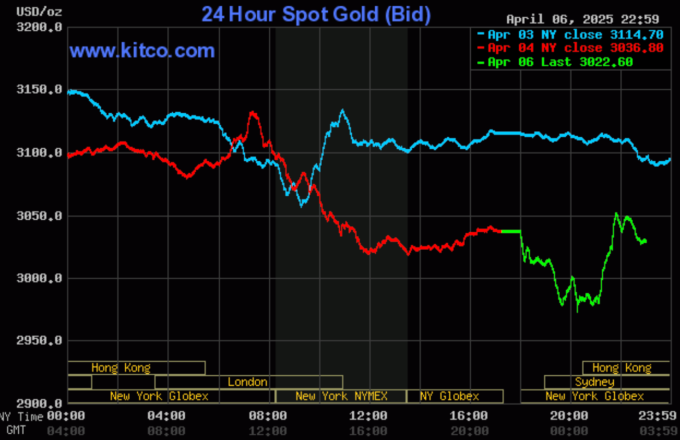
Fears of a recession caused by the global trade war launched by the US have caused investors to continue to sell off risky assets.
Japan's Nikkei 225 is down 6.3%, while Japan's Topix is down 7%. Both declines are narrowing from earlier in the session. In South Korea, the Kospi is down 4.5%. China's stock market is also down. The Shanghai Composite is down 5.5%, down from its opening. Hong Kong's Hang Seng Index is down nearly 9%.
In Taiwan, authorities triggered a circuit breaker on the stock market on the morning of April 7 after TSMC and Foxconn shares fell nearly 10%. Taiwan is also one of the major trading partners of the US, and is subject to a 32% reciprocal tariff.
Australia's S&P/ASX 200 opened down 6% and has since pared losses to 4%. The index has now fallen into correction territory since Friday's close, down 11% from its February peak.
US stock market futures are also falling. DJIA futures are down 1,200 points, or 3.3%. S&P 500 and Nasdaq 100 futures are down 3.8% and 4.8%, respectively.
European stock market futures were also not spared. EUROSTOXX 50 futures fell 3%. FTSE futures (UK) fell 2.7% and DAX futures (Germany) are currently down 3.5%.
Meanwhile, US President Donald Trump said on April 6 that he was not worried about the stock market decline. "I don't want anything to go down. But sometimes you have to take medicine to cure it," Trump said, comparing US stocks to "medicine to cure a disease."
Trump’s stance also coincides with US Commerce Secretary Howard Lutnick’s April 6 statement that the administration would continue to impose tariffs on major trading partners, even as global stock markets plunged. US Treasury Secretary Scott Bessent also revealed that more than 50 economies have requested to start negotiations since Mr. Trump announced the reciprocal tariffs.
Earlier, on April 5, Chinese Foreign Ministry spokesman Guo Jiakun said on his personal page that "the market has spoken" about Mr. Trump's import tariffs. Guo's post was accompanied by a photo showing the US stock market plummeting.
US stocks sold off sharply last weekend after China announced retaliatory tariffs. Canada followed suit. Last week was also the first time in history that the DJIA recorded two consecutive sessions of declines of more than 1,500 points. The S&P 500 lost 5.9% - the lowest since March 2020. The Nasdaq Composite - which tracks many technology stocks - fell 5.8%.
In currency markets, investors rushed to buy safe-haven assets such as the Japanese yen and the Swiss franc. The Swiss franc is now up more than 0.6% to CHF0.85 per dollar. Last week, the currency gained 2.3% against the US dollar.
Meanwhile, the USD price decreased by 0.45% compared to the yen. Currently, each US dollar can only be exchanged for 146.2 yen. At the beginning of the session on April 7, the greenback had at one point lost more than 1% compared to the Japanese currency.
Opening the trading session on April 7, world gold prices fluctuated strongly. At the beginning of the session, the price dropped to $2,980 an ounce - the first time it lost the $3,000 mark since mid-March. The market then immediately turned around and increased, currently at $3,041.

Last week, the market fell sharply for several consecutive sessions, as investors sold to take profits after the market peaked at $3,169 on April 2 because the US imposed reciprocal tariffs on all trading partners. Another reason was that assets such as stocks lost value, forcing investors to sell gold to add more money to their "margin call" accounts.
This morning’s performance is consistent with Kitco News’ forecast last week. Experts believe that gold prices will continue to decline in the short term, still for the two reasons mentioned above. However, the medium-term uptrend remains intact due to unresolved uncertainties.
Crude oil prices also did not escape the general decline. globally. Brent crude oil is currently down 2.8% to $63.7 a barrel. US WTI crude oil is down similarly, to $60.2. Investors are worried that US-China trade tensions will spark a recession, reducing oil demand. China is currently the world's leading crude oil consumer.
TH (according to VnExpress)Source: https://baohaiduong.vn/chung-khoan-chau-a-giam-sau-dai-loan-dung-giao-dich-408875.html




![[Photo] Closing of the 11th Conference of the 13th Central Committee of the Communist Party of Vietnam](https://vstatic.vietnam.vn/vietnam/resource/IMAGE/2025/4/12/114b57fe6e9b4814a5ddfacf6dfe5b7f)

![[Photo] Overcoming all difficulties, speeding up construction progress of Hoa Binh Hydropower Plant Expansion Project](https://vstatic.vietnam.vn/vietnam/resource/IMAGE/2025/4/12/bff04b551e98484c84d74c8faa3526e0)














































































Comment (0)